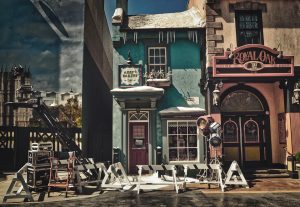Literature
62 Elements of Literature: Setting, Theme

Setting
Setting is where the action in the story takes place. There are two main kinds of settings:
- General Setting: the less specific and larger time and place in which a story takes place—the the overall time and area.
- e.g., A story may be set in the early twenty-first century in a small town in the interior of British Columbia
- e.g., Europe in between the two World Wars
- Specific Setting: the exact time and place in which a specific part of the story happens.
- e.g., In a scene in a story, the sisters are in their parents’ car driving home after school.
- e.g., at the corner between two buildings at dusk on New Year’s Eve
Theme
Theme is the meaning that you get out of a story. The theme is not given to readers directly—it is something that readers must figure out on their own.
- Example: a theme of a story may be unrequited love (love for someone who doesn’t return that love).
- Example: The theme of a story may be overcoming great obstacles to succeed in life.
- Examples: “love,” “family loyalty,” “human behaviour in wartime.”
Theme is a major concept the writer wants to explore with their work. It is usually a universal, abstract idea that any person could understand.
Problems with Theme
- Have you ever had a hard time finding “the theme” in a story?
- Have you ever received a poor grade on an answer or assignment about theme?
I pose this vote to my students, and I get a lot of hands up over these questions. I have noticed that there are three main reasons why students have trouble with theme:
- Students will believe that there is “one” theme in a story.
- This is a problem with the wording of a question. There can, and will, be many possible themes in a story. The question may be asking what is “the most significant theme”—a much different possibility.
- Students may feel that they are wrong about a theme.
- As long as it is a reasonable possibility that most people could recognize, you are not “wrong.”
- Unless you think that a major theme in “Goldilocks and the Three Bears” is “interracial marriages,” you are probably not wrong.
- But who would think that about “Goldilocks”? If you are thinking it, you are probably fine to explore it.
- Students may not focus appropriately on only one theme (that they have selected as significant through their own understanding); instead, they may throw many different ideas into their assignment about the theme in a given story.
- As with any assignment, a discussion of theme needs to be unified around a central idea and cohesive in that it proves only that main idea.
- A theme about childhood poverty that might come out of “The Little Match Girl” should not include dangers of roads for children, the effects of cold upon the mind, and parent-child relationships. (Unless you will use each of those to prove that childhood poverty.)
- As with any assignment, a discussion of theme needs to be unified around a central idea and cohesive in that it proves only that main idea.
Exercise
Choose your own short story, or use a story your instructor has assigned. Use examples from the story where applicable.
- What is the general setting of the story?
- Choose two scenes and describe the specific setting for each scene. (2 marks)
- How much dialogue is there in this story?
- Give two examples of the most frequent dialogue in the story. (2 marks)
- Is there internal dialogue? Yes / No
- What theme do you see in this story? Give a few examples of how the theme revealed itself to you. (3 marks)
Use these digital flashcards to review setting and theme:
Media Attributions
- Movie Scenes Film Backdrop Free Photo by McRonny is licensed under a CC0 (Creative Commons Zero) Licence.

